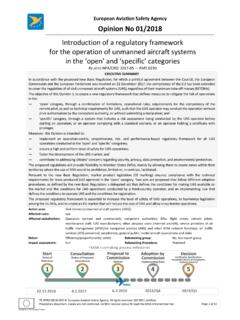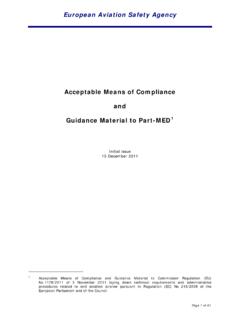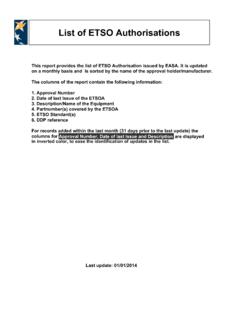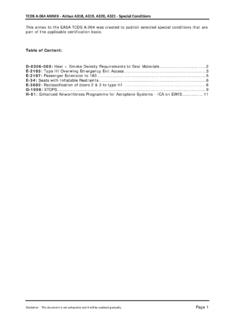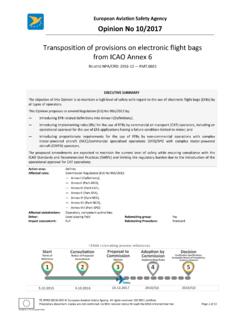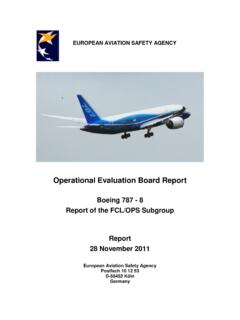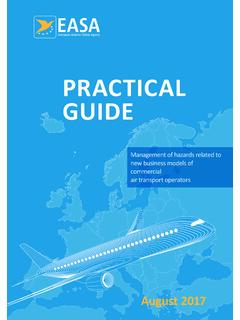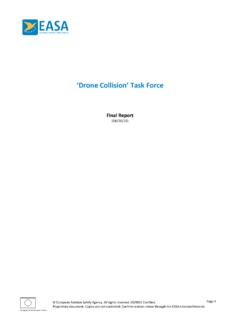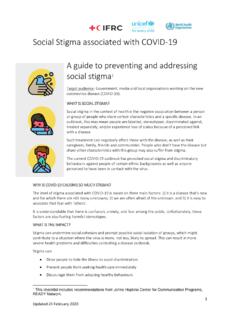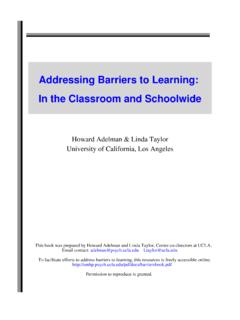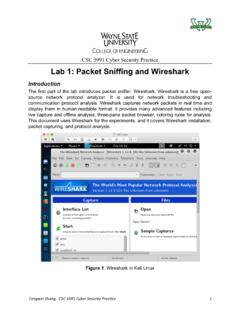Transcription of Special Condition for small-category VTOL aircraft
1 Special Condition Vertical Take-Off and Landing (VTOL) aircraft Doc. No: SC-VTOL-01 Issue: 1 Date: 2 July 2019 i Special Condition for small-category VTOL aircraft Statement of Issue The Agency has received a number of requests for the type certification of vertical take-off and landing (VTOL) aircraft , which differ from conventional rotorcraft or fixed-wing aircraft . In the absence of certification specifications for the type certification of this type of product, a complete set of dedicated technical specifications in the form of a Special Condition for VTOL aircraft has been developed. This Special Condition addresses the unique characteristics of these products and prescribes airworthiness standards for the issuance of the type certificate, and changes to this type certificate, for a person-carrying VTOL aircraft in the small category, with lift/thrust units used to generate powered lift and control.
2 SC-VTOL-01 Issue 1 1 CONTENTS PREAMBLE SUBPART A GENERAL Applicability and definitions Certification of small-category VTOL aircraft Accepted means of compliance SUBPART B - FLIGHT Mass and centre of gravity Performance data Flight Envelopes Take-off performance Climb requirements Climb information Landing Controllability Control forces Flying qualities Stall characteristics and stall warning (reserved) Vibration Flight in icing conditions FLIGHT INFORMATION Operating Limitations SUBPART C -STRUCTURES Structural design envelope Interaction of systems and structures STRUCTURAL LOADS Structural design loads Flight load conditions Ground and water load conditions Component loading conditions Limit and ultimate loads STRUCTURAL PERFORMANCE Structural strength Structural Durability Aeroelasticity SC-VTOL-01 Issue 1 2 Design and construction principles Protection of structure Materials and processes Special factors of safety STRUCTURAL OCCUPANT PROTECTION Emergency conditions SUBPART D DESIGN AND CONSTRUCTION Flight control systems Landing gear systems Flotation OCCUPANT SYSTEM DESIGN PROTECTION Means of egress and emergency exits Occupant physical environment FIRE AND HIGH ENERGY PROTECTION Fire
3 Protection Fire Protection in designated fire zones Lightning Protection Design and construction information SUBPART E LIFT/THRUST SYSTEM INSTALLATION Lift/thrust system installation (reserved) (reserved) Lift/thrust system installation ice protection (reserved) Lift/thrust system operational characteristics Lift/thrust system installation, energy storage and distribution systems Lift/thrust installation support systems Lift/thrust system installation fire protection Lift/thrust system installation information SUBPART F SYSTEMS AND EQUIPMENT General requirements on systems and equipment function General requirements on equipment installation Equipment, systems, and installations Electrical and electronic system lightning protection High-intensity radiated fields (HIRF) protection System power generation, energy storage, and distribution SC-VTOL-01 Issue 1 3 External and cockpit lighting Safety equipment (reserved) Pressurised systems elements (reserved) Installation of recorders SUBPART G FLIGHT CREW INTERFACE AND OTHER INFORMATION Flight crew compartment Installation and operation information Instrument markings, control markings and placards Flight, navigation, and lift/thrust system instruments aircraft Flight Manual Instructions for Continued Airworthiness AMC Equipment, systems, and installations (partial) SC-VTOL-01 Issue 1 4 PREAMBLE Why a Special Condition ?
4 EASA has reviewed more than 150 VTOL project configurations, at different stages of maturity, all aiming at addressing a potentially new market. The available data shows that there are a wide variety of configurations with limited common characteristics except for a VTOL capability and distributed propulsion. Despite having design characteristics of aeroplanes, rotorcraft or both, in most cases EASA was not able to classify these new vehicles as being either a conventional aeroplane or a rotorcraft as covered by the existing certification specifications. Applying either the certification specifications for aeroplane or for rotorcraft, depending on whether they are rather an aeroplane or rather a rotorcraft, and only adding some modifications would not ensure equal treatment. These new types of vehicles are designed to address the same new market even though not always the same segments.
5 However CS-23 and CS-27 have significant differences, especially in terms of system Safety Objectives and Operational aspects. EASA opinion is that it would not be fair to treat applicants differently based on the regulatory starting point (CS-23 or CS-27) as it would probably favour some configurations, thus preventing potentially innovative concepts to compete on the market. Instead, EASA favours to use objective based certification requirements, which provide the necessary flexibility to certify innovative state-of-the-art designs and technology, to establish a common set of conditions for the certification of these new concepts. Therefore EASA developed this VTOL Special Condition extensively based on CS-23 Amendment 5, which is also largely harmonised with the FAAs Part 23, integrating elements of CS-27 and new elements where deemed appropriate. Accepted Means of Compliance (AMC) will be developed and, when considered necessary, the most significant ones may be consulted publicly.
6 The establishment of a common set of conditions will enable a fair competition and clarity for future potential applicants. In addition, it will enable EASA to consider all vehicles with a Certification Basis based on the VTOL Special Condition as Special Category aircraft . This classification will provide greater flexibility in the Operational regulatory framework by enabling to tailor requirements to this type of aircraft rather than having to use aeroplane or helicopter regulations. Applicability The Special Condition has been established to prescribe the technical specifications for the type certification of a person-carrying vertical take-off and landing (VTOL) heavier-than-air aircraft in the small category, with lift/thrust units used to generate powered lift and control. The distinction from conventional aeroplanes is based on the VTOL capability of the aircraft while the distinction from conventional rotorcraft is based on the use of distributed propulsion, specifically when more than two lift/thrust units are used to provide lift during vertical take-off or landing.
7 The Special Condition is intended to be compatible with a remote piloting capability or different levels of autonomy, however these aspects are not currently addressed by this Special Condition . Flight crew references will be considered as applicable when material for remote piloting and autonomy is added. EASA has decided to set the scope of the VTOL Special Condition up to the CS-27 small rotorcraft limits, with a passenger seating configuration of 9 or less and a maximum certified take-off mass of 3 175 kg (7 000 lbs) or less. This decision has been motivated by several comments received and provides the possibility to align with the CS-23 aeroplane certification levels 1 to 3 and potentially the future UAS Safety Continuum. SC-VTOL-01 Issue 1 5 Link to type of Operations In order to be proportionate to the nature and risk of particular activity to be conducted by VTOL aircraft , two certification categories are introduced in this Special Condition , namely Basic and Enhanced, linked to the intended type of operations.
8 A direct relationship between airworthiness and types of operations already exist, for example when certifying for VFR or IFR operations. Introducing this additional link allows proportionality in safety objectives and enables to apply the highest safety levels of Category Enhanced to protection of third-parties when flying over congested areas and when conducting commercial air transport of passengers. The operational rules can then be built on demonstrated aircraft safety levels and adapted as necessary to local particularities. VTOL aircraft that are certified in the Category Enhanced would have to meet requirements for continued safe flight and landing, and be able to continue to the original intended destination or a suitable alternate vertiport after a failure. Whereas for Category Basic only controlled emergency landing requirements would have to be met, in a similar manner to a controlled glide or autorotation.
9 The types of operations that the Category Enhanced aircraft will perform correspond to the highest operational risk to third parties and/or to passenger transport for remuneration. For this reason the most stringent system safety objectives are assigned regardless of the number of occupants. These safety objectives have been established based upon two complementary EASA evaluations which converged on a numerical value of the same order of magnitude. The first evaluation considered the underlying assumptions of the current certification specifications, in particular CS-25, CS-27/29 and CS-23. The EASA evaluation aligned with the considerations included in FAA AC , when referring to Classes of Airplanes, or Assessment Levels in the ASTM standards, and the associated upper limit for the average probability per flight hour for catastrophic failure conditions ( < for Class I): These classes were defined based on the way accident and safety statistics are currently collected.
10 Generally, the classes deal with airplanes of historical equivalent levels of system complexity, type of use, system reliability, and historical divisions of airplanes according to these characteristics. However, these classes could change because of new technologies. The placement of a specific airplane in a class should be done in reference to all of the airplane s missions and performance characteristics. EASA concluded that the levels of system complexity that is introduced by the distributed propulsion and corresponding advanced flight controls is deemed sufficiently unusual and novel that the current CS-23 acceptable means of compliance are no longer considered appropriate for determining the aircraft and system safety objectives. The second evaluation was based on the Concept of Operations that were provided by applicants and further complemented by market projection analyses.
